
Holyoke is a city in Hampden County, Massachusetts, United States, that lies between the western bank of the Connecticut River and the Mount Tom Range. As of the 2020 census, the city had a population of 38,247. Located 8 miles (13 km) north of Springfield, Holyoke is part of the Springfield Metropolitan Area, one of the two distinct metropolitan areas in Massachusetts.

Tartan Day is celebration of Scottish heritage and the cultural contributions of Scottish and Scottish-diaspora figures of history. The name refers to tartan, a patterned woollen cloth associated with Scotland. The event originated in Nova Scotia, Canada, in 1987. It spread to other communities of the Scottish diaspora and Scotland itself in the 1990s to 2000s.
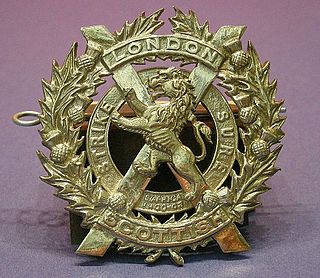
The London Scottish was a reserve infantry regiment then a company of the British Army. In its final incarnation it was A Company, the London Regiment until, on 1 May 2022, soldiers in the company transferred to foot guards regiments and the company became G (Messines) Company, Scots Guards, 1st Battalion London Guards.
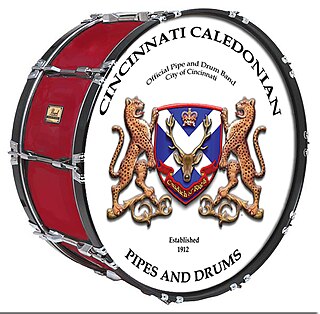
Cincinnati Caledonian Pipes and Drums is a pipe band based in Cincinnati, Ohio. They have been honored to play for The Black Watch, share a stage with Rod Stewart, play the half time show for the Cincinnati Bengals, and perform at the Cincinnati Celtic Festival since it started in the early 1990s. The band has led the Cincinnati St. Patrick’s Day parade since at least 1969. Their big event each year is the annual Tartan Day Cèilidh held in conjunction with National Tartan Day in early April.

The Kentucky Scottish Weekend was a regional Highland games event held annually at General Butler State Resort Park in Carrollton, Kentucky. The weekend's mission was to celebrate the customs and traditions of Scotland. It was held each year on the second full weekend in May. First held in 1983, the weekend celebrated its thirtieth anniversary in 2012, its final year. It was the longest running highland game currently being held in Kentucky at the time it ended. It was held in Carrollton due to that location being nearly halfway between Louisville and Cincinnati. A Kentucky non-profit corporation—Kentucky Scottish Weekend, Inc.—held the event. The weekend was sometimes referred to as "KSW" for short.
The Manchester Pipe Band is a grade two pipe band from Manchester, Connecticut. It was founded in 1914 and is the second oldest pipe band in continuous existence in the United States, after the Holyoke Caledonian Pipe Band which inspired its founding. Currently, the band competes in grade 3 of the Eastern United States Pipe Band Association. The band has previously been in Grade 2, in which it took second place in 2007 and first place in 2009.
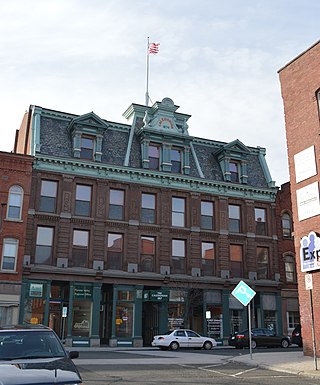
The Caledonia Building, also known as Caledonian Hall or The Caledonian, is a historic commercial building located at 185-193 High Street in downtown Holyoke, Massachusetts. Built in 1874, it is one of that commercial district's finest examples of Victorian architecture and a rare representative example of the development of the city's Scottish immigrant community. It was listed on the National Register of Historic Places on July 3, 1979, and was included in the North High Street Historic District on June 26, 1986.
The Regimental Band and Pipes was founded on the Citadel campus in Charleston, South Carolina, in 1909, with marine general Harry K. Pickett in command. The marching band makes up one of the twenty-one companies of the South Carolina Corps of Cadets. In 1991, the band participated in the Edinburgh Military Tattoo in Scotland, becoming the first military college selected for the honor. They returned in 2010 as the only unit from the United States to appear at the Silver Jubilee of the Tattoo and appeared again in 2015 and 2024.

The United States Air Force Pipe Band was a highland unit of the United States Air Force. Organized in 1960 from a predecessor unit that had been activated in 1950, it was deactivated ten years later.
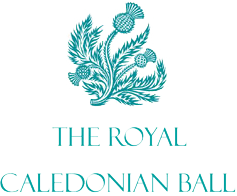
The Royal Caledonian Ball is a ball held annually in London for the benefit of Scottish charities. With few exceptions, the Royal Caledonian Ball has been held annually since 1849, and is the oldest charity ball in the world.
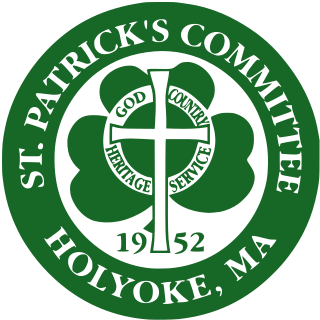
Holyoke Saint Patrick's Day Parade is hosted every year on the Sunday of the week of Saint Patrick's Day. Each parade usually attracts around 400,000 spectators from all over the United States of America. Past participants have included President John F. Kennedy, two Speakers of the House and other notable officials.

The Valley Arena Gardens, most commonly referred to as the Valley Arena, was a sporting and entertainment venue in Holyoke, Massachusetts, best known for hosting weekly boxing matches which included Rocky Marciano's debut professional fight. Though best known for its history as a boxing venue, the Valley Arena also hosted wrestling, basketball, roller hockey, miniature golf and featured its own restaurant. As a nightclub and theatre in the round venue it also hosted an array of vaudeville acts such as The Three Stooges and Bela Lugosi, as well as renowned musicians including Count Basie, Duke Ellington, The Ink Spots, The Dorsey Brothers, The Glenn Miller Orchestra, Sarah Vaughan, and The Temptations. In an interview with Woody Herman and band alumni, Jack Dulong, saxophonist and member of Herman's "Third Herd", described it as "an 'institution' for big bands."

Springdale is a neighborhood in Holyoke, Massachusetts located to the south of the city center, approximately 1 mile (1.6 km) from downtown, on the banks of the Connecticut River. Initially established as Day's Landing for its first settlement, the neighborhood features Springdale Park, originally known as Riverside Park, which was designed by the influential Olmsted Brothers landscape architecture firm, as well as light industry and machine shops, residential housing, and the central supply warehouse of Holyoke Public Schools. The mixed zoning neighborhood was developed as a streetcar suburb by brickmaker John J. Prew, who gave the area its name and devised the first street plans and building lots for the area in 1887 as housing for millworkers of South Holyoke. Since 1984, Springdale Park has hosted the city's annual Western Massachusetts Puerto Rican Parade, a three-day annual event in June celebrating the city's Latin culture and music.

During the late 19th and early 20th centuries Holyoke saw an influx of Franco-Americans, predominantly French-Canadians, who immigrated to Massachusetts to work in the city's growing textile and paper mills. By 1900, 1 in 3 people in Holyoke were of French-Canadian descent, and a 1913 survey of French Americans in the United States found Holyoke, along with other Massachusetts cities, to have a larger community of French or French-Canadian born residents than those of New Orleans or Chicago at that time. Initially faced with discrimination for the use of their labor by mill owners to undermine unionization, as well as for their creation of separate French institutions as part of the La Survivance movement, this demographic quickly gained representation in the city's development and civic institutions. Holyoke was at one time a cultural hub for French-Canadian Americans; the Saint-Jean-Baptiste Society of America was first organized in the city in 1899, along with a number of other institutions, including theater and drama societies from which famed vaudevillian Eva Tanguay was first discovered, and regular publications, with its largest French weekly newspaper, La Justice, published from 1904 to 1964. The city was also home to author Jacques Ducharme, whose 1943 book The Shadows of the Trees, published by Harper, was one of the first non-fiction English accounts of New England's French and French-Canadian diaspora.
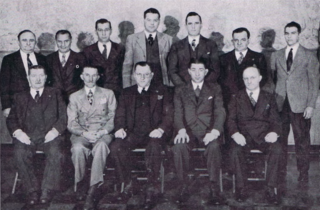
Despite representing a significantly smaller population than their Irish, French, Polish, or Puerto Rican counterparts, in the late 19th century through the mid-20th century, German immigrants predominantly from Saxony and Rhineland played a significant economic, cultural, and political role in the history of Holyoke, Massachusetts. The influx of these immigrants can largely be attributed to a single mill and millworker complex, the Germania Woolen Mills, which formed the basis of the immigrant colony that would make the ward encompassing the South Holyoke neighborhood that with the highest German population per capita, in all of New England by 1875. Along with unionization efforts by the Irish community, Germans would also play a key role in the city and region's socialist labor movements as workers organized for higher pay and improved living conditions in the textile and paper mill economies.
This is a timeline of the history of the city of Holyoke, Massachusetts, USA.

From the beginning of the city's history as the western bank of Springfield, Irish families have resided in and contributed to the development of the civics and culture of Holyoke, Massachusetts. Among the first appellations given to the city were the handles "Ireland", "Ireland Parish", or "Ireland Depot", after the village was designated the 3rd Parish of West Springfield in 1786. Initially occupied by a mixture of Yankee English and Irish Protestant families, many of whom belonged to the Baptist community of Elmwood, from 1840 through 1870 the area saw a large influx of Irish Catholic workers, immigrants to the United States, initially from the exodus of the Great Famine. During that period Irish immigrants and their descendants comprised the largest demographic in Holyoke and built much of the early city's infrastructure, including the dams, canals, and factories. Facing early hardships from Anti-Irish sentiment, Holyoke's Irish would largely build the early labor movement of the city's textile and paper mills, and remained active in the national Irish nationalist and Gaelic revival movements of the United States, with the Holyoke Philo-Celtic Society being one of 13 signatory organizations creating the Gaelic League of America, an early 20th century American counterpart of Conradh na Gaeilge.
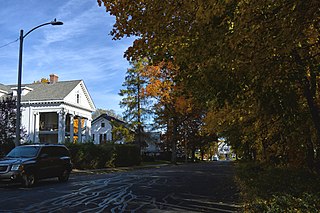
Highland Park is a neighborhood in Holyoke, Massachusetts located to the northwest of the city center, approximately 1 mile (1.6 km) from downtown, on the banks of the Connecticut River. The neighborhood features Jones Park, originally itself known as Highland Park, which was designed by the influential Olmsted Brothers firm. The residential neighborhood was initially developed as a streetcar suburb by the Highland Park Improvement Association, which underwent several iterations between 1893 and 1930. Today the neighborhood contains numerous Victorian and early 20th century housing and about 219 acres (89 ha) of residential zoning, as well as the Edward Nelson White School.
As of the 2010 United States Census, there were 39,880 people, 15,361 households, and 9,329 families residing in the city of Holyoke, Massachusetts. The population density was 723.6/km2 (1,874/mi²). There were 16,384 housing units at an average density of 277.2/km2 (718.6/mi²).

The Worcester Kiltie Pipe Band is a Grade 2 pipe band from Worcester, Massachusetts. It is led by pipe major David Methven and lead drummer Colum Lundt. They compete in the United States, Canada, the United Kingdom, and other nations. Worcester Kiltie wears the Modern Scott tartan. They were the first band from the United States to rise to prominence in Grade 1, and in 1964 became the first US band to compete at the World Pipe Band Championships.

















